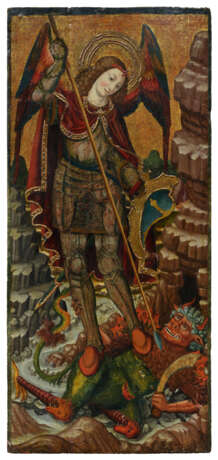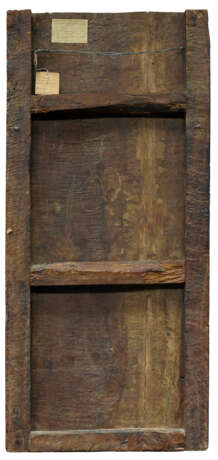ID 1336074
Лот 4 | ÉCOLE CATALANE DE LA FIN DU XVe SIÈCLE
Оценочная стоимость
€ 40 000 – 60 000
Saint Michel terrassant le Mal
tempera et huile sur panneau et fond d'or, sans cadre
139,5 x 65,5 cm (5415/16 x 25 ¾ in.)
Provenance
Monsieur et Madame John A. Morgan ;
Donné par ceux-ci au Los Angeles County Museum of Art, Californie (no. inv. 63.44) ;
Vendu par le Los Angeles County Museum of Art au profit d'acquisitions futures ; vente anonyme, Christie's, New York, 10 janvier 1990, lot 102 (comme école catalane de la fin du XVe siècle).
Acquis au cours de celle-ci par la famille de l'actuel propriétaire.
Literature
S. Schaefer et al., European Painting and Sculpture in the Los Angeles County Museum of Art. An Illustrated Summary Catalogue, Los Angeles, 1987, p. 104 (comme espagnol [Catalogne] vers 1500), reproduit en noir et blanc.
Further details
CATALAN SCHOOL LATE 15th CENTURY, SAINT MICHAEL SLAYING EVIL, TEMPERA AND OIL ON GOLD GROUND PANEL, UNFRAMED
The iconography of Saint Michael overcoming Evil has evolved over the centuries, reflecting the changing spiritual concerns of different eras. Saint Michael, the warrior archangel, is traditionally depicted in armour, brandishing a sword or spear, triumphing over the dragon symbolising Evil. This image, which has its roots in the Apocalypse of Saint John (Revelation 12, 7-9), has been interpreted and reinterpreted, with each artist contributing his or her own vision and style. In the first centuries of Christianity, depictions of the archangel were essentially symbolic. The archangel was usually depicted alone in armour, trampling a fairly uncomplicated dragon. However, from the Middle Ages onwards, artists began to enrich the iconography with more elaborate details, influenced by apocryphal accounts and local legends.
A fascinating iconographic feature of the presnt painting, in comparison with other compositions on the same subject painted in the same historical context, such as Saint Michael Slaying the Dragon by Bartolomé Bermejo (1440-1498) (National Gallery, London, inv. no. NG6553), is the representation of Evil as an anthropomorphic devil whose body - the stomach and knees in the case of our painting - is covered with multiple heads. This interpretation reached its apogee in Gothic and Renaissance art, where the monstrosity of Evil is accentuated by the multiplication of diabolical faces on the beast's body. An engraving by the monogrammist ES, a German engraver active around 1450-1467, depicting the fight of the archangel in which Evil is represented in this anthropomorphic guise (British Museum, London, no. inv. 1851, 1213.119) attests to the spread of this particular iconographic practice.
These complex and terrifying representations serve several purposes. They illustrate the medieval belief in an omnipresent and protean evil, capable of manifesting itself in a thousand ways to deceive and corrupt humanity. The many human heads also symbolise the various temptations and sins that beset the faithful. Each face, often grimacing or grotesque, is an allegory of a particular vice, making Saint Michael's struggle all the more heroic and symbolic.
| Техника исполнения: | Масло на панели |
|---|---|
| Художественный стиль: | Старые мастера |
| Место происхождения: | Европа, Испания |
| Категория аукционного дома: | Картины, Акварели, Рисунки, Картины |
| Техника исполнения: | Масло на панели |
|---|---|
| Художественный стиль: | Старые мастера |
| Место происхождения: | Европа, Испания |
| Категория аукционного дома: | Картины, Акварели, Рисунки, Картины |
| Адрес торгов |
CHRISTIE'S 8 King Street, St. James's SW1Y 6QT London Великобритания | |
|---|---|---|
| Предосмотр |
| |
| Телефон | +44 (0)20 7839 9060 | |
| Комиссия | see on Website | |
| Условия использования | Условия использования |




